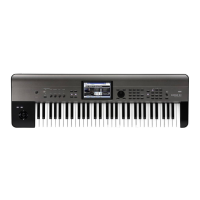10. COMBI, PROG, SEQ buttons
11. GLOBAL, MEDIA buttons
The KROME has five different operational modes, each one optimized for a specific set of functions. Press one of
these buttons to enter the corresponding mode.
For details, please see “Selecting modes” on page 11.
PROG/COMBI BANK
12. A, B, C, D, E, F buttons
These buttons select program banks AF, U-AU-F and combination banks AF (see page 12). The program bank will
switch from AF to U-AU-F and back, with each consecutive press of a BANK button. You can also use these buttons
to select the bank of timbre programs in a combination, or the bank of track programs in a song. If you want to select
a GM bank, use the numeric keys (see “15”, below, page 12) or the Bank/Program Select menu (see page 13).
VALUE controllers
Use these controllers to edit the parameter that’s selected in the display.
13. INC and DEC buttons
14. VALUE dial
15. 09, and . buttons
16. ENTER button
Use these to specify the value of the selected parameter.
17. COMPARE button
Compares your current sound edits to the sound before it was edited.
PAGE SELECT, EXIT
18. PAGE button
When you press this button, a list of the pages within the selected mode will appear in the display. Press the button of
the desired page. (See page 9 of the Operation Guide)
19. EXIT button
Press this button to return to the main page of the current mode.
20. WRITE button
Use this button to save programs, combinations, global settings, drum kits, or arpeggio patterns to the internal
memory (see page 20). You’ll also use this button to save songs to media (see page 21).
Sequencer
The buttons in this section are used for operations in Sequencer mode, such as recording and playback (see page
54 of the Operation Guide). In addition to its use during recording, the REC button is also used to save a program or
combination, or when using the Auto Song Setup function (see page 16).
21. PAUSE button, REW button, FF button, LOCATE button, REC button,
START/STOP button
TEMPO controls
22. TEMPO knob, TEMPO LED
This knob adjusts the tempo of the arpeggiator, drum track, or internal sequencer. This LED will blink at quarter-note
intervals of the current tempo.
23. TAP button
By pressing (or tapping) this button on the beat, you can enter the tempo used by the arpeggiator, drum track, or
internal sequencer.
Headphone
24. Headphone jack
Connect your headphones here. This jack will output the same signal as the AUDIO OUTPUT L/MONO and R jacks.
The headphone volume is controlled by the VOLUME knob.
Rear Panel

